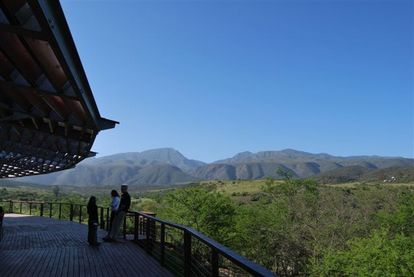
In a remote wilderness area in the Eastern Cape of South Africa, a very interesting initiative is taking place. A group of diverse stakeholders are working together to restore this area to what is termed a ‘living landscape’*. A ‘living landscape’ has a variety of healthy eco-systems and land-uses and is home to ecological, agricultural and social systems which are managed so that they function sustainably. This ensures that natural and cultural resources are available for future generations.
The Baviaanskloof Mega-Reserve is a special place, worthy of preservation for future generations. It has recently been declared a World Heritage site, both ecological and cultural. Ecologically it has 6 out of 7 biomes represented in South Africa which makes it botanically very diverse. Culturally it has always been the meeting point of cultures with Stone Age archeology, San rock paintings and more recent habitation. It also forms the catchment area for water which ultimately funnels into a number of rivers (Kouga, Baviaanskloof and Groot River which runs into the Gamtoos River) and dams (Kouga & Lourie) which provides water for a large area for the use of agriculture and municipalities including the larger Nelson Mandela Municipality area (the city of Port Elizabeth). In a water-stressed country such as South Africa, this makes the Baviaanskloof Mega-Reserve a very important place.
The Baviaanskloof mega-reserve is also a classic example of a complex social ecological system. Ecologically it is complex with a rich diversity of landscapes, while an intricate social system interacts with the ecological system through a variety of stakeholders who have an interest in the restoration and preservation of the landscape, the conservation and sustainable use of water.
To name just a few, stakeholders such as the Eastern Cape Parks Board (ECPB), the Department of Water and Forestry and municipalities using water from the dams downstream have a great interest in the catchment area. The reserve consists of a mix of private and government land which are managed together by ECPB. These create a complex mix of upstream and downstream land owners, which in turn supports communities of farm workers and small towns. Due to its ecological importance, other interested parties include scientists and researchers from universities both in South Africa and abroad, including the Dutch Ministry of Agriculture, Nature and Food Quality which is providing funding for research.
It is in this context that the PRESENCE Learning Network operates. PRESENCE is short for Participatory Restoration of Ecosystem SErvices & Natural Capital, Eastern Cape) and is coordinated by Dieter van den Broeck and Matthew Zylstra from Living Lands. PRESENCE aims to be an adaptive learning community which serves as a dynamic platform to support and catalyze restoration efforts.
The importance of social learning in a complex social ecological system such as the Baviaanskloof Mega-Reserve cannot be underestimated. A complex system is unpredictable and therefore hard to manage. The ability of the system and community to be a learning community, which constantly learns from itself through cycles of action and reflection, allows it to be more responsive to changes in the environment.
The PRESENCE learning network is aiming to be the focus of this learning community. Extensive scientific research is happening to establish the status quo and to understand the social ecological system and its complexities. There are also ongoing action research projects which are intervening in the system, with monitoring fed back into reflective practices. This allows the community to learn from the research and make meaning from it. This is done through regular learning events and through a virtual communication platform.
Becoming a learning network and operating as one is an ongoing collaborative effort, with no immediate end in sight. The cliché of ‘it’s about the journey and not the destination’ is quite applicable here. Great strides have been made to form a community who sees itself as one with a common vision and purpose. The power of this learning network was demonstrated to me when I participated in a learning workshop event last week. Apart from the spectacular venue for the workshop (see attached picture), I was struck by the energy of mutual commitment to this vision, by the participants. Scientists, farmers and government officials were passionately collaborating in efforts to find ways to further the restoration efforts in ways which will balance the interests of the community overall.
For me, as a learning consultant and coach this is a fascinating effort to be involved with. I am drawn to it as it gives me an opportunity to contribute my experience in learning organisations, and also to learn from this learning network at the same time. I am challenged to figure out how can I support this community to be more mindful of its individual and collective learning processes? Is this working with individual stakeholders or with the community as a whole? Can I design experiential learning interventions which help others to engage with this system and subsequently further the vision of this network?
True to the nature of complexity, my role and participation in this learning network is emerging as we are journeying together towards a sustainable future.
* This definition adapted from work done by Andrew Knight from University of Stellenbosch.